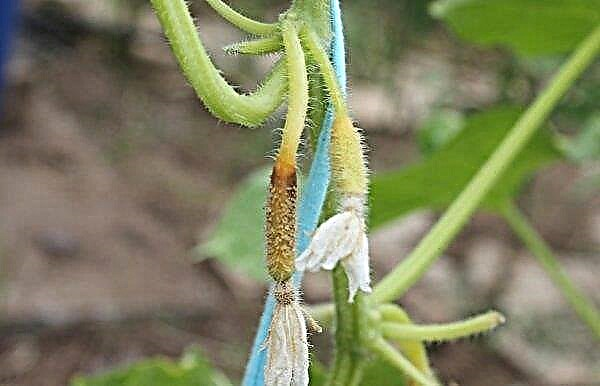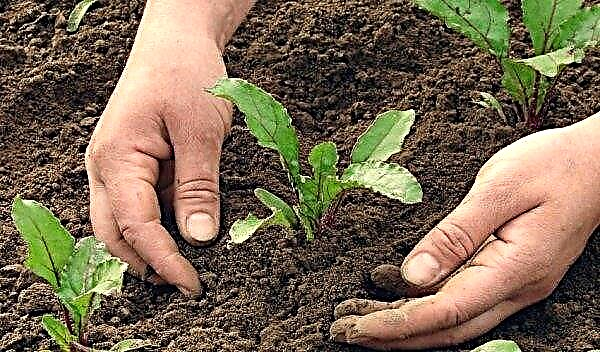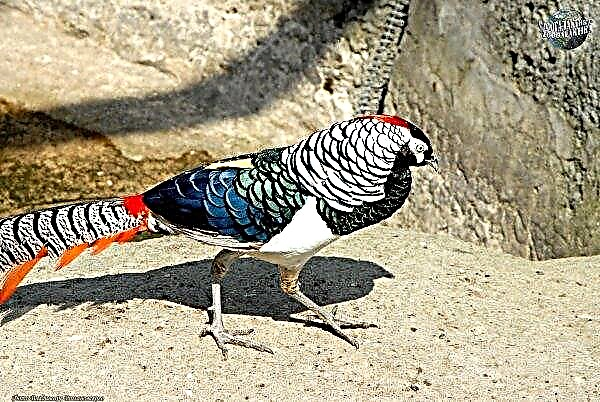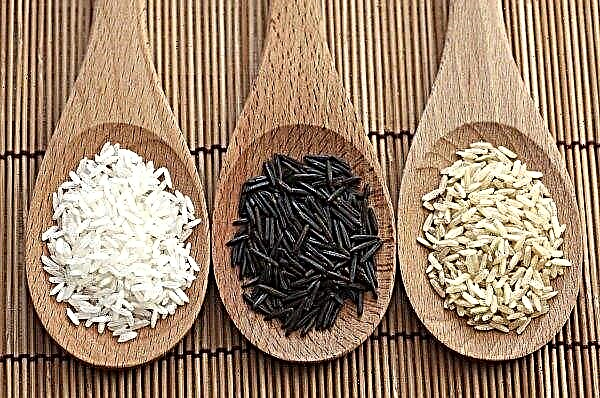Very often, land owners, growing tomatoes, sooner or later face the problem of curling leaves, their yellowing and drying. This article will help you understand what the reason for the deformation of the leaf plate in tomatoes, and how to deal with it.
Why do tomatoes twist leaves, and what to do
There are many reasons for this phenomenon, but almost all of them are associated with a violation of the cultivation technology or with diseases of this culture. When the leaves are twisted by a boat, the process of photosynthesis slows down. The plant does not receive the right amount of nutrients, which leads to a significant decrease in yield.
The main causes of leaf folding can be divided into two groups: non-infectious and infectious.Did you know? When Karl Linney (a naturalist from Sweden) first saw a tomato, he named it "Solanum lycopersicum»that translates as «wolf peach».
The first is associated with a violation of growing technology and consists in excessive watering, an overabundance or lack of fertilizers, hot weather, improper removal of stepsons or damage to the root system of the plant. The second group includes damage to the bush by various bacteria, which first lead to the twisting of the leaf plate up, and then to a decrease in the leaf cover on the top of the tomatoes, which as a result leads to the death of the plant as a whole. To avoid these problems, it is necessary to accurately determine the cause, to know how to treat tomatoes (chemical or folk remedies), and also how to feed tomatoes, if necessary.
To avoid these problems, it is necessary to accurately determine the cause, to know how to treat tomatoes (chemical or folk remedies), and also how to feed tomatoes, if necessary.
Heat
In summer, very often the thermometer rises above + 30 ° C. The consequence of exposure to high temperature is the twisting of the leaves, regardless of the place of cultivation (in open ground or in a greenhouse).
In the heat of tomatoes, the leaves not only curl into a tube, but also ovaries and flowers fall. If tomatoes are grown in a greenhouse, then the temperature can be reduced by opening the windows and doors. True, drafts negatively affect the growth rate of tomatoes. The optimal temperature for plants in the greenhouse is + 21 ° C - + 23 ° C during the day and + 17 ° C - + 19 ° C - at night. If these indicators cannot be adhered to, then the greenhouse is additionally covered with a white cloth, which will reflect part of the sun's rays.
It is more difficult to protect tomatoes from scorching rays in the open ground. To protect plants, it is shaded with special materials (agrofibre or a special mesh). It is also necessary to provide tomatoes with regular watering (early in the morning and in the evening). And mulching the soil will protect the bushes from the rapid loss of moisture. As a mulching layer, you can use a layer of coniferous needles, grass or organic fertilizers. Additionally, the soil is watered with a solution of nitroammofoski (with a calculation of 15-20 g per each square meter of the site).Did you know? The word "tomato" has undergone many changes: among the Aztecs, this plant sounded like "tomato", and the French called it "tomate". As a result, the word "tomato" came to the Russian language.
 If the leaves are strongly twisted, then regardless of the place of growing the plants, you can treat it with an aqueous solution of urea or urea. The solution is prepared as follows (for 8-10 plants): 1.5 tablespoons are added to a bucket of water. l carbamide. The resulting solution is sprayed with tomatoes. WITH
If the leaves are strongly twisted, then regardless of the place of growing the plants, you can treat it with an aqueous solution of urea or urea. The solution is prepared as follows (for 8-10 plants): 1.5 tablespoons are added to a bucket of water. l carbamide. The resulting solution is sprayed with tomatoes. WITHafter letting go for 3 days, the bushes are re-processed, but this time they use an aqueous solution of potassium sulfate (potassium sulfate). Plus, from 8 to 10 g of inorganic fertilizer is added to a bucket of water. The resulting solution is sprayed with 10-12 plants.
You can use the method that was used by our grandmothers. Plants are sprayed with a solution of laundry soap and chalk. One ten-liter bucket will require 0.5 kg of chalk and a small amount of soap (so that the water is soapy, “sticky”). Sprinkle the leaves with the resulting solution, and you can additionally process the soil. This procedure can be carried out during the day. After processing, the leaves will turn white, and to the touch - cool.
Lack or excess of fertilizer
Every agronomist knows that without fertilizers it is impossible to get a good crop, but its overabundance can also cause irreparable damage to the plant. For tomatoes, both result in leaf curl and yield reduction.
It is important to accurately determine the cause of the deformation of the leaf plate. So, with excessive accumulation of zinc in the soil, the leaf plates twist, as with a lack of fertilizer. An overabundance of this element on the plant causes the purple color of the leaves.
With a large amount of nitrogen fertilizer, the leaves begin to deform at the very top of the plant. To neutralize the excess nitrogen will help fertilizing with potassium sulfate or the introduction of wood ash around the trunk into the soil, which will be previously loosened and watered.Important! If twisted and shriveled leaves of bright green color appeared on a tomato bush, then a large amount of manganese accumulated in the soil.
To eliminate an excess of manganese in the soil is quite difficult, but possible: it is necessary to add 4 times more iron than manganese. Replacing the soil or refusing top dressing that contains zinc will solve the problem of excess zinc. If the soil is sod-podzolic, then it already has zinc in its composition. The application of this mineral fertilizer can lead to the death of the plant. You can observe that the leaves are twisted outward, and apical rot appears on the fruits. Restore calcium balance by adding a mixture of calcium nitrate, wood ash and carbide. All these substances are bred in 1 bucket of water in the ratio: 18–22 g of saltpeter, 350–400 g of ash and 8–12 g of carbide. This mixture is applied as a basal top dressing, and it is enough for 3-4 m².
You can observe that the leaves are twisted outward, and apical rot appears on the fruits. Restore calcium balance by adding a mixture of calcium nitrate, wood ash and carbide. All these substances are bred in 1 bucket of water in the ratio: 18–22 g of saltpeter, 350–400 g of ash and 8–12 g of carbide. This mixture is applied as a basal top dressing, and it is enough for 3-4 m².
Due to the lack of fertilizer, drying and deformation of the leaf cover of tomatoes can also be observed. This deficiency is compensated by applying the right amount of fertilizer. If, however, twisted gray leaves appeared on the tomato bush, this indicates a deficiency of phosphorus. In this case, watering the bushes with a solution of superphosphate will help. To do this, 80-90 g of the substance is dissolved in a bucket of water and watered plants (this volume is enough to process an area of 3-4 m²).
To restore nitrogen, they often resort to folk methods. In a ten-liter bucket of water, 0.5 l of liquid cow manure and 1 tbsp. nitrofoski. The resulting mixture is watered with tomatoes. You can also fertilize plants with concentrated nettle infusion.  To do this, nettle greens are placed in a container (you can take a barrel) and kept under scorching sunlight for a week. The resulting slurry is diluted with water in a ratio of 2:10. Only 0.5 l of fertilizer is enough for one bush. This top dressing is carried out 2 times with a break of 10 days.
To do this, nettle greens are placed in a container (you can take a barrel) and kept under scorching sunlight for a week. The resulting slurry is diluted with water in a ratio of 2:10. Only 0.5 l of fertilizer is enough for one bush. This top dressing is carried out 2 times with a break of 10 days.
Lack of moisture
Tomatoes love plentiful watering. It should also be systematic. Especially if the plants have just been planted. However, very often the irrigation regime is violated. And if compared with the abnormally hot weather, which is becoming almost the norm, the bush is experiencing a severe moisture deficit.
When planting seedlings, tomatoes need 4-5 liters of water so that they are well rooted and take root in a new place. After planting in the soil, it is necessary to water the seedlings after 9-11 days from the moment of transplantation; from each bush you need to pour from 6 to 8 liters of water.Did you know? The fruit of a wild tomato weighs no more than 1 g, and the fruit of cultivated plants — 1 kg or more.
 Before the appearance of peduncles and fruits, young plants are watered as necessary: in greenhouse conditions - 1-2 times depending on temperature, in open ground in the absence of rainfall, the irrigation frequency is increased. Tomatoes that are grown in the open air need to be watered every week, on one bush - from 5 to 7 liters of water.
Before the appearance of peduncles and fruits, young plants are watered as necessary: in greenhouse conditions - 1-2 times depending on temperature, in open ground in the absence of rainfall, the irrigation frequency is increased. Tomatoes that are grown in the open air need to be watered every week, on one bush - from 5 to 7 liters of water.When an ovary appears on the plant, the amount of water is increased by 1/3. However, do not lose sight of the weather.
When the tomatoes do not receive the required amount of moisture, the leaves begin to wrap inward, which minimizes the loss of moisture. To restore the water balance, it is necessary to pour 1.5-2 liters of water daily under the bush. If the edges of the sheet are bent outward, then this indicates a waterlogged soil. When signs of excess moisture appear, watering is stopped for 10-15 days.
A layer of mulch will help retain moisture in the soil. Folk sages recommend the use of coniferous needles and foliage, but recently a "lazy garden" has gained great popularity, the principle of which is sheltering soil with freshly picked weeds. The plant will receive additional nutrients that are formed during the process of rotting the mulch.Important! It is necessary to water tomatoes early in the morning or in the evening when there is no heat. Use the necessary water at room temperature.

Shortage of batteries
It is necessary to maintain a balance in everything: from top dressing and watering to the "amount" of sunlight. If there is an imbalance in something, the plant is sick. First of all, the leaves suffer, which for the agronomist is a good indicator of tomato health. So, it can be observed that with a deficiency of copper, the leaves turn yellow and twist. Appeared yellow spots may later turn black. To replenish the balance of copper will help drugs that contain copper (this can be "Oksih" or "HOM").
In addition to the lack of phosphorus and copper, there may be a deficiency of other trace elements:
- if the foliage is bent inward and the tip is curled (this is especially evident in seedlings), then this indicates a deficiency of zinc;
- the deformation of young leaves indicates a lack of boron;
- young shoots have become smaller - a lack of sulfur and copper;
- the foliage turned pale, and twisting is observed - insufficient amount of Ca;
- leaves turned yellow and sagging - iron deficiency.
Did you know? Tomato foliage is toxic. After its processing, it is used in the fight against aphids, caterpillars and other pests.
 To compensate for the lack of these elements, you can use immunomodulators, which can be used in hot weather. When it’s cool and the humidity is high, you can use the solution “Solution” or “Epin”.
To compensate for the lack of these elements, you can use immunomodulators, which can be used in hot weather. When it’s cool and the humidity is high, you can use the solution “Solution” or “Epin”.Infused wood ash is suitable as top dressing (just add 2 cups of ash to a bucket of water). By the way there will be a solution of yeast, sugar and ash. To do this, add 100 g of wet yeast and 0.5 cups of sugar to 3 liters of water, stir everything well and leave it in a warm place for 7 days. After this time, the resulting mixture is diluted in 10 liters of water and a 0.5 liter can of ash is added. Consumption of the resulting mixture: 1 liter per tomato bush.
Root damage
If the root system of the plant was damaged during the transplant, the leaf plate will also deform. It is difficult to help the plant, it needs time to recover. On average, it is from 4 to 5 days, provided that the soil contains all the necessary nutrients and a sufficient amount of moisture.
So that the roots are not damaged during the plant transplantation to the main place, experienced gardeners recommend using organic pots for seedlings. Peaty ones are ideal, which not only protect young roots from damage, but also become a good nourishment for the future plant. Organic Seedling Pots
Organic Seedling Pots
Incorrect removal of stepchildren
In order for the tomatoes to grow up and not waste their energy (they did not branch strongly, and the excessive deciduous cover did not curl), young shoots called stepchildren are regularly removed from the plant. Although this procedure is effective, however, very often after it the leaves begin to turn yellow, and sometimes even the inflorescences fall off, thereby signaling that the plant has received stress. This situation occurs if a large number of stepsons (or sufficiently developed ones, which were not removed in a timely manner) are removed.
Important! Only young shoots that are no more than 5 cm long should be removed. Such «cleaning» Tomatoes tolerate quite calmly and painlessly.
Stepsons are removed in the morning, not cutting, but breaking off young shoots. Those places where there were stepchildren must be treated in order to protect the plant from harmful microorganisms. As a disinfectant, you can use birch tar or a 2% solution of hydrogen peroxide. If, after removing the stepsons, you notice that the leaves of the tomatoes curl and dry, then emergency measures must be taken. The plant is fertilized with a biostimulator or other complex fertilizers by spraying the drug over the bush. In a week, positive changes will be noticeable, but such stress will negatively affect yield.
If, after removing the stepsons, you notice that the leaves of the tomatoes curl and dry, then emergency measures must be taken. The plant is fertilized with a biostimulator or other complex fertilizers by spraying the drug over the bush. In a week, positive changes will be noticeable, but such stress will negatively affect yield.
Pests and diseases
The twisting of the leaf plate can be caused not only by improper care of the plant, but also as a result of the attack of pests or various diseases.
Tomatoes begin to hurt if the seedlings were quite densely planted, there is no regular processing of plants, and the soil does not loosen. Such diseases can be bacteriosis, phytoplasmosis, columnar tomato or bacterial cancer.
If on a tomato bush leaves began to curl up, and inflorescences and fruits stopped developing, then this can be caused by bacteriosis. It is very difficult to treat it, since the plant begins to fade very quickly, and the signs of such a disease can appear in just one night. If you examine the diseased bush in detail, you will notice that the stem inside is empty, there is fluid in it, and the internal tissues are brownish in color. The best way to deal with this disease is to remove the affected bushes. In order to avoid further spread, experts recommend spraying all plants (even if there are no signs of the disease) with Fitolavin-300. The drug is diluted in an amount of 0.6–1 ml per 1 liter of water. The resulting solution is watered each bush with a volume of at least 200 ml. Such treatment will delay the infection of healthy plants for 2-3 weeks.
If you examine the diseased bush in detail, you will notice that the stem inside is empty, there is fluid in it, and the internal tissues are brownish in color. The best way to deal with this disease is to remove the affected bushes. In order to avoid further spread, experts recommend spraying all plants (even if there are no signs of the disease) with Fitolavin-300. The drug is diluted in an amount of 0.6–1 ml per 1 liter of water. The resulting solution is watered each bush with a volume of at least 200 ml. Such treatment will delay the infection of healthy plants for 2-3 weeks.
Symptoms of phytoplasmosis are deformation and further twisting of the leaf plate in the upper part of the plant (later on it acquires a characteristic pinkish or purple hue). The lower foliage turns yellow. The most effective drug in the fight against such a disease is Phytoplasmin, which is treated with plants in accordance with the instructions.
Important! In rainy weather, you can’t process the plant, since all efforts will be in vain. This is best done in cloudy but dry weather. And in the hot treatment is carried out in the early morning or evening, when the sun's rays are not so scorching.
All plants can be treated twice with a solution of malathion. To prepare it, you need 10 liters of water and 20 g of the drug.
With the development of bacterial cancer in tomatoes, the leafy plate begins to deform, and then simply fades. Specific black spots appear on young shoots. The plant is affected gradually: first, the lower leaves, and then the cancer affects the entire plant, rising up. The disease spreads very quickly with excessive watering and damage to the root of the tomato. Bacterial Tomato Cancer It is difficult to treat a plant, but it is possible to warn the plant in the early stages. When the first signs of the disease appear, the bush is treated with Bordeaux liquid, copper sulfate or copper oxychloride. Before processing, it is necessary to loosen the soil, since during processing the solution with which the plant will be processed will fall into the soil.Processing should begin with the lower leaves and soil, then gradually rising to the top.
Bacterial Tomato Cancer It is difficult to treat a plant, but it is possible to warn the plant in the early stages. When the first signs of the disease appear, the bush is treated with Bordeaux liquid, copper sulfate or copper oxychloride. Before processing, it is necessary to loosen the soil, since during processing the solution with which the plant will be processed will fall into the soil.Processing should begin with the lower leaves and soil, then gradually rising to the top.
Foliage twisting can be observed during the attack of pests, since most of these insects feed on sap obtained from the leaves of plants. Most often, tomatoes attack a spider mite, whitefly and aphid.
Whitefly is a butterfly that prefers to settle on the lower tiers of greenhouse plants. Identifying such a pest is quite simple: you just need to shake the foliage, thereby disturbing the butterfly. It is worth finding it - and the cause of suffering is determined. In the fight against whitefly, any insecticides that are available on the market will help. If you are a supporter of an environmentally friendly garden, you can use folk remedies. Solutions from tincture of yarrow and laundry soap will help. The solution is made with a calculation of 5 l: take 150 g of the plant and ½ bar of soap. The resulting mixture is treated early in the morning or evening with tomato bushes, starting from the lower leaves. For preventive purposes, the bush can be periodically treated with tincture of dandelions (500 g of plants are added to a 3 liter jar) or garlic (4-6 heads per 10 liter bucket).
If you are a supporter of an environmentally friendly garden, you can use folk remedies. Solutions from tincture of yarrow and laundry soap will help. The solution is made with a calculation of 5 l: take 150 g of the plant and ½ bar of soap. The resulting mixture is treated early in the morning or evening with tomato bushes, starting from the lower leaves. For preventive purposes, the bush can be periodically treated with tincture of dandelions (500 g of plants are added to a 3 liter jar) or garlic (4-6 heads per 10 liter bucket).
Another pest that is quite common in greenhouse conditions and less commonly in open ground is the spider mite. He eats foliage juice, which also leads to curling and yellowing of the leaf plate. A visual inspection of the plant reveals a thin web.Important! Processing of tomatoes (especially insecticidal preparations) should be carried out no later than 20 days before the ripening of the crop.
Various chemical preparations that are aimed at combating ticks (the so-called acaricides) will help to remove the spider mite. These drugs can be bought at any store that specializes in selling seeds and other drugs for processing crops. The most popular are Oberon, Flumight and Borneo. Spider mite on tomatoes Help in the fight against this pest and folk remedies. You can treat the plant with tincture of green onions, garlic or dandelions. To prepare such solutions, insist on 500 g of onions and dandelions or from 10 to 15 cloves of garlic in 3 l of water.
Spider mite on tomatoes Help in the fight against this pest and folk remedies. You can treat the plant with tincture of green onions, garlic or dandelions. To prepare such solutions, insist on 500 g of onions and dandelions or from 10 to 15 cloves of garlic in 3 l of water.
When growing tomatoes in open soil, these plants are most often attacked by aphids. She likes to settle on the top of a bush. Revealing it is easy enough. Additional evidence of the appearance of aphids on the plant are ants, which are the main carriers of these pests. It is the presence of ants that complicates the fight against aphids. They will help fight both with ants and with aphids “Iskra” or “Aktara”.
If the aphid colonies are insignificant, you can cope with alternative methods. It is enough to process the bush with infusion of wormwood or celandine. To do this, 500 g of wormwood is insisted in a 3 l jar (or 250 g of celandine in the same volume). You can add 70 - 80 g of laundry soap in tincture (this will increase the area of coverage of plants with the mixture). Aphids on tomatoes Periodic treatment with ash solution will also be helpful. To prepare it, 300 g of wood ash and 1 bucket of water will be required. This mixture is insisted for 2 days, which allows to increase the nutritional value of the solution. When it is ready, they begin to spray the plant from the top of the head, gradually dropping down.
Aphids on tomatoes Periodic treatment with ash solution will also be helpful. To prepare it, 300 g of wood ash and 1 bucket of water will be required. This mixture is insisted for 2 days, which allows to increase the nutritional value of the solution. When it is ready, they begin to spray the plant from the top of the head, gradually dropping down.
Preventative measures
The following precautions should be taken to prevent these problems and crop loss:
- if the summer is hot enough in your region (the mercury column rises above + 30 ° C), you need to shade the plants and additionally periodically treat with a solution of urea or potassium permanganate;
- the use of potassium monophosphate or “Solution” will allow for a balanced nutrition of tomatoes;
- additional mulching of the soil with manure or other organic fertilizer will preserve the nutritional value of the soil;
- Regular watering, taking into account weather conditions, will protect the plant from excess or lack of moisture;
- with the appearance of aphids, whiteflies or spider mites, it is worth using special preparations. As a prophylaxis against aphids, the plant can be periodically treated with wood ash, and tincture from yarrow and laundry soap will help from whiteflies, from spider mites - from dandelion, garlic or green onions;
- if the tomato bushes suffer from bacteriosis, then they are immediately removed, since the disease can quickly spread to healthy plants. It is necessary to immediately treat healthy bushes with special preparations;
- if the leaves are curled at tube, and at the same time there is a thickening of the branches and the trunk, you should increase the frequency of watering, since the plant suffers from an excess of nitrogen in the upper layers of the soil;
- stepsoning will help to restore the bush after applying a large amount of fertilizer;
- with a lack of moisture, the plant experiences stress, and the leaves curl with a boat. To eliminate such consequences, it is necessary to increase watering, and only after 7-14 days the leaf cover of tomatoes will return to normal.

Useful Tips
When growing tomatoes, some useful tips will come in handy:
- during greenhouse cultivation of tomatoes, the temperature can be adjusted using open or closed windows and doors;
- white fabric helps to protect plants from hot rays in the greenhouse. Tomatoes that are grown in the open ground, shaded with agrofibre or other specialized materials;
- regularly remove young stepsons from the plant;
- periodic spraying will not only protect against pests and diseases, but also minimize the negative impact of various factors (meaning lack of nutrients, exposure to high temperatures). Processing plants is necessary taking into account weather conditions and 3 weeks before harvesting;
- water the tomatoes with settled water at room temperature.












